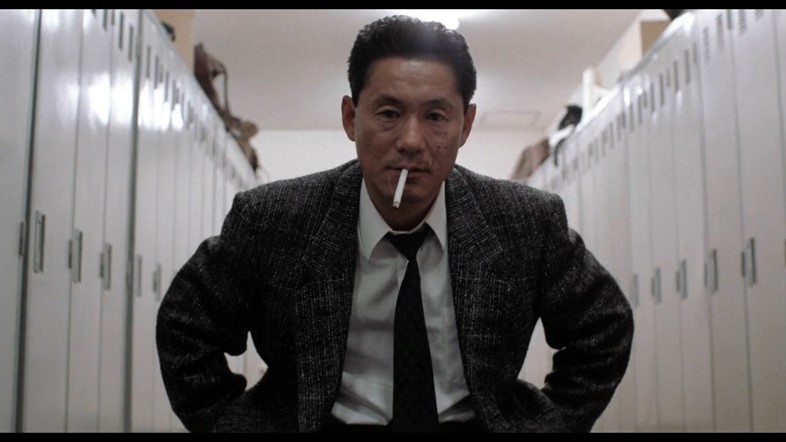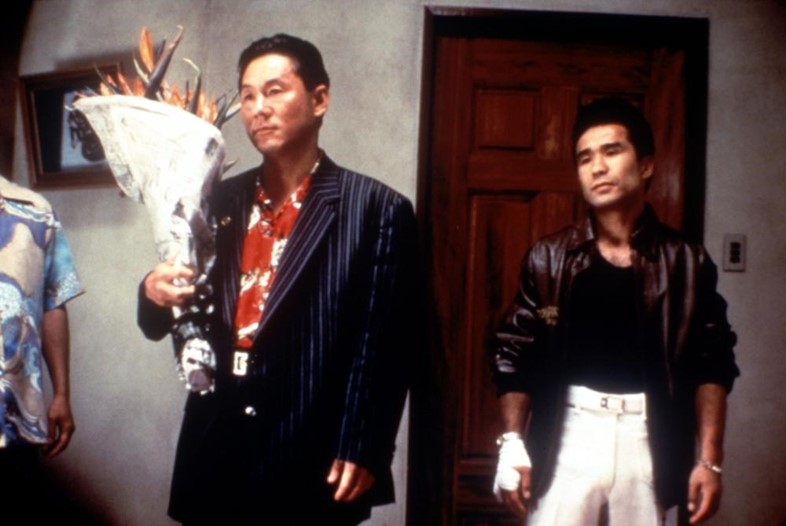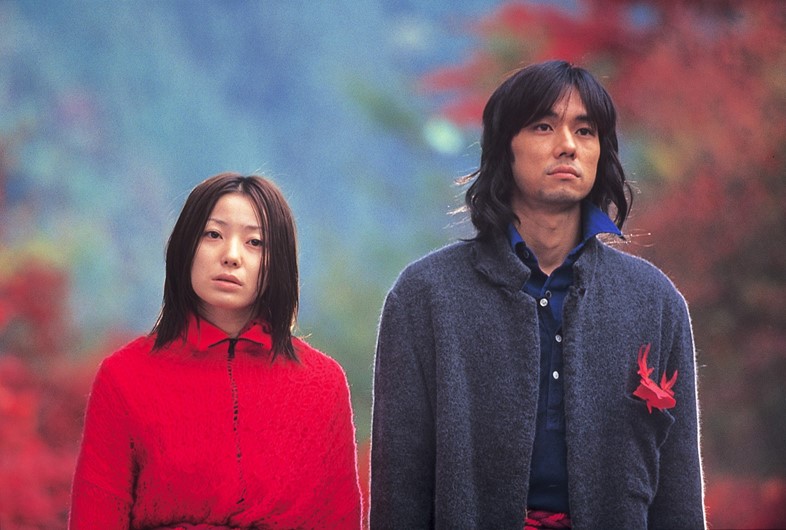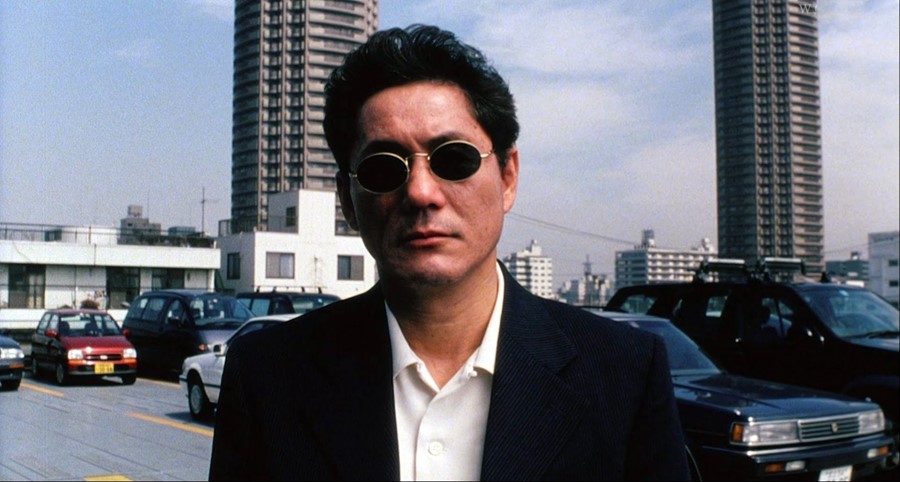Revisit the best style moments in director Takeshi Kitano’s films – with three featuring costumes designed by Yohji himself
From the purists convinced it can’t live up to the original, to the controversy surrounding the Hollywood ‘whitewashing’ of the Japanese animation, the furore around the release of Ghost in the Shell has been unavoidable these last few weeks. Whatever your thoughts on the issue, there’s one thing that stands out as really exciting; the film marks the return of multi-talented director, producer, writer, actor, presenter, poet(!) Takeshi Kitano to English-language cinema for the first time since 2000’s Brother. He plays Aramaki, the public security chief.
Having made his name in Japan as one half of controversial comedic duo Two Beat in the 70s, Kitano directed – and starred in – his first film Violent Cop in 1989. If you’re not familiar with it, the film is (perhaps unsurprisingly) about a violent policeman and his efforts against a group of yakuza gangsters that have kidnapped his sister. Showcasing the elements that would come to be known as Kitano signatures; long static shots, an often muted colour palette, dark humour, and minimal dialogue, Violent Cop also provided a first-look at a key aspect of all the director’s films – a strong, distinctive set of costumes.
Owing much to the minimalistic stylings of Japanese designers including Rei Kawakubo of Comme des Garçons, Issey Miyake and Yohji Yamamoto, the costumes throughout Kitano’s films provide an understated backdrop to what is often pretty graphic violence. The predominantly muted, often monochrome costumes – particularly the louche tailoring worn by many of his yakuza characters – are offset by frequent splatters of blood, which provides some of the only vivid colour in some of his more brutal films including Violent Cop, Hana-Bi and Brother.
Of the designers that Takeshi Kitano visually referenced in his films, it quickly became apparent that the admiration was reciprocated by one; Yohji Yamamoto declared himself a ‘Takeshi Kitano nut’ in the mid-90s and the two teamed up for the first time in 2000, with Yamamoto designing the costumes for LA-set yakuza drama Brother.
With Kitano and Yohji both the recipients of a cult-like level of devotion among fans, the partnership has so far spanned four films, the last of which, Dolls, is widely regarded as Kitano’s best work.
We take a look at some of their best collaborative work – and the most stylish moments in Kitano’s films in general.
VIOLENT COP, 1989

‘Beat’ Kitano (the name Takeshi goes by in all acting roles) stars as Detective Azuma, a policeman gone rogue after the suicide of his friend and colleague and the kidnapping of his sister at the hands of the local yakuza. With Azuma spending much of his time in a grey tweed suit, the tailoring in Violent Cop is slimmer and more refined than that of Kitano’s subsequent work, more indebted to fitted, 1950s style suits. The formal aesthetic of the costumes and coolly-delivered, detached dialogue offers a bold contrast against the uncompromising violence of the film – and all of the blood that gets spilled throughout.
BOILING POINT, 1990

Boiling Point follows two baseball-playing slackers whose coach is being threatened by (yes more) yakuza, prompting them to hatch a plan to buy guns and seek revenge on the group. Playing the role of a psychotic gangster, Kitano’s look is a lot more louche this time around as he sports more relaxed silhouettes than those seen in Violent Cop. The pinstripe suit that the actor wears for much of the film, with its classically 90s-style wide shoulders and creases, is paired with a floral, Hawaiian-style shirt – it’s a casual look unbefitting the coldness of Kitano’s character, but demonstrates once more the director’s propensity for contrast and the unexpected. The floral shirt went on to become a key element of many of his films, worn by characters in Kikujiro and Sonatine among others.
A SCENE AT THE SEA, 1991

A Scene at the Sea was Kitano’s third directorial outing and a bit of a departure from his previous work. Showing the softer side of Kitano’s character, the film is a love story about a deaf rubbish man determined to learn to surf at all cost. The film is understated and slow-paced and the costumes reflect the romantic nature of the plot, with the characters showcasing the definitive 90s teen look of washed out sweatshirts, sneakers and faded 501s – original normcore stylings. A word of warning; if you’re watching this, you’re going to need some tissues.
BROTHER, 2000

Brother was the first Kitano film set outside of Japan and the first for which Yohji Yamamoto designed the wardrobe. Set in Los Angeles, the story follows Kitano as he relocates to the city and joins his brother in trying to take over the local drug trade. Contrasting pared-back Japanese tailoring against the late 90s/early 00s hip-hop styling of the rival Cholo mob, for much of the film Kitano is seen in a typically Yamamoto silhouette; a loose-fitting suit with a relaxed, wide-shouldered jacket and a boxy, spread-collar shirt. Looking calm and collected throughout as the body count rises to no fewer than 78 bodies, the look is finished with a pair of wire-rimmed sunglasses that wouldn’t look out of place on the Balenciaga catwalk today.
DOLLS, 2002

Kitano once again shows his more tender side with this unique story of three sets of lovers – a young businessman and his jilted fiancée, an ageing yakuza and the girl he abandoned thirty years prior and a disfigured pop star and her devoted fan – each bound together by a length of red rope as they wander Japan in search of something they have respectively lost. With barely any dialogue throughout, emphasis is placed on what is some of Kitano’s most beautiful cinematography, and Yohji Yamamoto’s outstanding costumes, based on those worn in Japanese bunraku puppet theatre. Rich with kaleidoscopic colour (in stark contrast to the melancholy nature of the story) the jerking movement of the characters is purposefully reminiscent of the dolls used in these traditional folklore productions.
TAKESHIS’, 2005

Do blondes have more fun? Kitano sets out to find out in 2005’s Takeshis’ as he plays two versions of himself – one of them sporting a peroxide crop – in the first of three surreal, Lynch-esque autobiographical films. As himself, he’s sharp as ever in Yamamoto tailoring, but as Mr. Kitano, his mild-mannered (at least to begin with) uber-fan, the look is more relaxed as he spends much of the film in dowdy knitted sweaters and slacks. This all changes as things get a whole lot darker and confused as Mr. Kitano switches out the separates for a (pretty incredible) abstract acid green and pink short-sleeved shirt. There’s also a scene in which Kitano and an accomplice don dark hooded ponchos in an effort to disguise themselves; by this point, Yohji Yamamoto has a few years at Y-3 under his belt and these cloaks are reminiscent of some of the designer’s technical pieces for the brand. Special mention goes to the scene in which Kitano drives a Barbie pink taxi carrying three cross-dressing Geishas through a field of corpses – the surreal nature of the film allowing Yamamoto to fully embrace the avant-garde for the first time as part of a Kitano feature.










